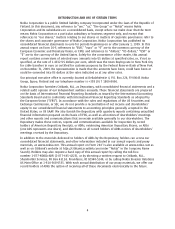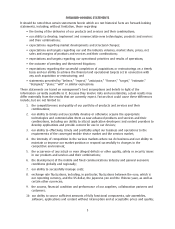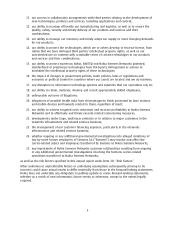Nokia 2009 Annual Report Download - page 13
Download and view the complete annual report
Please find page 13 of the 2009 Nokia annual report below. You can navigate through the pages in the report by either clicking on the pages listed below, or by using the keyword search tool below to find specific information within the annual report.3B. Capitalization and Indebtedness
Not applicable.
3C. Reasons for the Offer and Use of Proceeds
Not applicable.
3D. Risk Factors
Set forth below is a description of risk factors that could affect Nokia. There may be, however,
additional risks unknown to Nokia and other risks currently believed to be immaterial that could turn
out to be material. These risks, either individually or together, could adversely affect our business,
sales, results of operations, financial condition and share price from time to time.
We need to have a competitive portfolio of high quality products and services and their
combinations that are preferred, purchased and used by our current and potential customers
and consumers. If we fail to achieve or maintain a competitive portfolio, our business, sales
and results of operations may be materially adversely affected.
We serve a diverse range of mobile device and network infrastructure customers across a variety of
markets with different characteristics and at different stages of development. In order to meet our
customers’ and consumers’ evolving needs, we need to have a competitive portfolio of products and
services and their combinations that are preferred, purchased and used by our current and potential
customers and consumers.
For our mobile devices, a competitive portfolio means a focused, optimallysized offering of
commercially appealing high quality mobile devices with aestheticallypleasing and welldesigned
hardware and software, an intuitive user interface and a combination of valueadding
functionalities—such as Internet access, various means of messaging, media, music, entertainment,
navigation, locationbased and other services—that are easy to discover and use. In addition, we
believe that in order to be competitive, the product portfolio needs to target all major consumer
segments and price points, be designed, as appropriate, for the local requirements and preferences of
different markets and meet our own and our customers’ and consumers’ quality, safety and security
standards. We are focused on developing and offering unique and compelling combinations of mobile
devices and services, including applications and content developed by us and third parties, together
with the appropriate technological infrastructure, to create a rich user experience for people using
our devices. Further, our mobile devices, especially our converged mobile devices, must have the
flexibility to allow people to easily access and use their preferred services, including applications and
content. We believe that a competitive device portfolio also needs to include leading flagship
products, be innovative and ahead of the expectations of customers and consumers and positively
differentiated from those of our competitors. Further, the devices must be competitive not only from
the customers’ and consumers’ viewpoint, but they also need to be preferred by application
developers and content providers who are invited to develop applications and content for our mobile
devices. For our network infrastructure and related services business, a competitive portfolio means a
highquality offering of products, services and solutions based on robust technology and designed to
meet the requirements of our customers and local markets, supported by a competitive cost structure
and costeffectiveness to our customers. If we fail to achieve or maintain a competitive portfolio and
balance successfully our global portfolio with the local requirements of our customers and consumers
in the different markets we serve in a costeffective manner, our business, sales and results of
operations may be materially adversely affected.
In order to create a competitive portfolio we need to identify and understand the key market trends
and user segments and address our customers’ and consumers’ evolving needs in the different
markets and consumer segments proactively and on a timely basis. To achieve that, we must
constantly obtain and evaluate a complex array of customer feedback, information on consumer
11
























